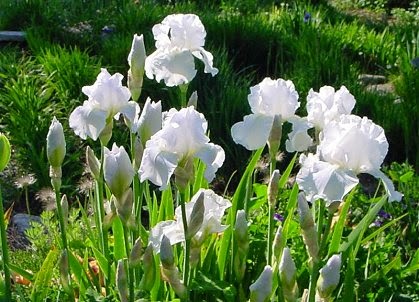By Virginia Spoon
Our garden in northern Virginia, zone 6, at an elevation of
1100 feet with alkaline soil, is almost a perfect location to grow bearded irises. In the
autumn the colors of the reblooming
irises blend with the leaves of the mountain maples, the black gums,
persimmons and dogwoods.
Mountain Maples in
the fall in our backyard. Image by--Ginny
Spoon
Reblooming SDBs, 'Eric Simpson'
with 'Ray Jones' in background. Image by --Ginny Spoon
As I am writing this article in mid October, the rebloomers
are putting on quite a show along with the changing leaves. Our weeping cherry
tree is changing color and the winterberries are starting to lose their leaves
while our resident Mockingbird is tirelessly guarding his hoard.
The weeping cherry
tree and winterberries at Winterberry Gardens. Image by --Ginny Spoon
Each day brings a new surprise while stalks appear as if by
magic. I thought 'Lord of Rings' matched the changing leaves of the cherry tree
so well.
'Lord of Rings' (George
Sutton 2003) reblooming in October at Winterberry--Image by-Ginny Spoon
It is so peaceful to wander around the garden and enjoy the sounds and colors and even the smells of autumn. Our Katsura tree now smells like burnt brown sugar and somewhere nearby, someone is burning leaves. A customer called a few days ago and asked about fragrant irises that matched their color. I remembered a few, but I had some rebloomers open and I checked the fragrance of 'Persimmon Pie' and remembered why we named it that. Also, 'Mango Parfait' was reblooming and it smelled like a fresh mango.
'Mango Parfait' (Don
Spoon) reblooming in October at Winterberry. Image by--Ginny Spoon
What would a fall garden be without the chrysanthemums?
There are perennial mums that come back
every year and their colors blend in well with the rebloomers. Ours grow beside
our entrance and I must remember to plant some among the irises next spring.
Perennial mums at
Winterberry. Image by-Ginny Spoon
Rebloomer, 'Doubleday'(George
Sutton 2001) Image by--Ginny Spoon
Winterberry Gardens, our woods in autumn --image by Ginny Spoon
Enjoy the crisp fall weather and all of the sights, sounds
and smells because ... Winter is coming.
Our resident Mockingbird guarding the winterberries in winter. Image--Ginny Spoon














